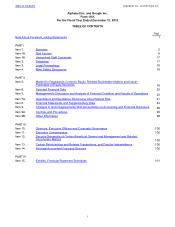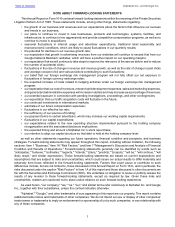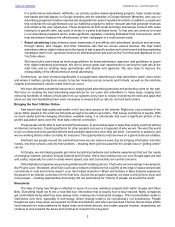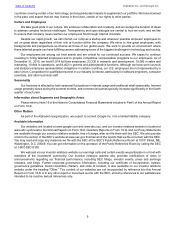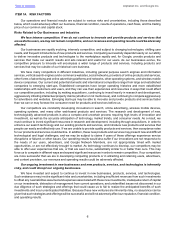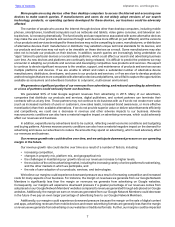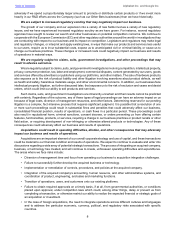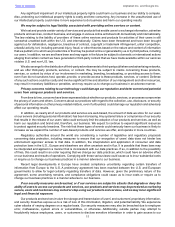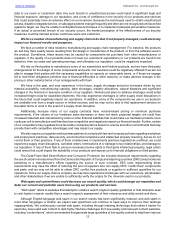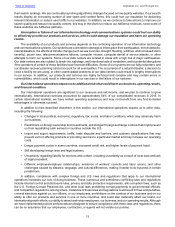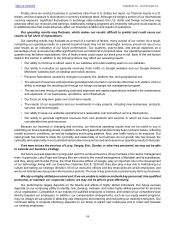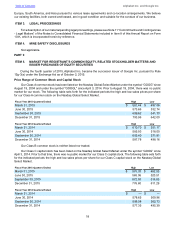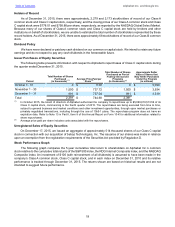Google 2015 Annual Report Download - page 14
Download and view the complete annual report
Please find page 14 of the 2015 Google annual report below. You can navigate through the pages in the report by either clicking on the pages listed below, or by using the keyword search tool below to find specific information within the annual report.
Table of Contents Alphabet Inc. and Google Inc.
10
We face risks and costs overseas as our products and services are offered in international markets and may be
subject to additional regulations. Any failure on our part to comply with these laws and regulations can result in negative
publicity and diversion of management time and effort and may subject us to significant liabilities and other penalties.
We are, and may in the future be, subject to intellectual property or other claims, which are costly to
defend, could result in significant damage awards, and could limit our ability to use certain technologies in
the future.
Internet, technology, media, and other companies own large numbers of patents, copyrights, trademarks, and
trade secrets and frequently enter into litigation based on allegations of infringement or other violations of intellectual
property rights. In addition, patent holding companies may continue to seek to monetize patents they have purchased
or otherwise obtained. As we have grown, the intellectual property rights claims against us have increased and may
continue to increase as we develop new products, services, and technologies.
We have had patent, copyright, and trademark infringement lawsuits filed against us claiming that certain of our
products, services, and technologies infringe the intellectual property rights of others. Third parties have also sought
broad injunctive relief against us by filing claims in U.S. and international courts and the U.S. International Trade
Commission (ITC) for exclusion and cease and desist orders, which could limit our ability to sell our products or services
in the U.S. or elsewhere if our products or services or those of our customers or suppliers are found to infringe the
intellectual property subject to the claims. Adverse results in any of these lawsuits may include awards of substantial
monetary damages, costly royalty or licensing agreements (if licenses are available at all), or orders preventing us
from offering certain features, functionalities, products, or services, and may also cause us to change our business
practices, and require development of non-infringing products or technologies, which could result in a loss of revenues
for us and otherwise harm our business.
Furthermore, in connection with our divestitures, we have agreed, and may in the future agree, to provide
indemnification for certain potential liabilities. In addition, many of our agreements with our customers and partners,
including certain suppliers, require us to indemnify them for certain intellectual property infringement claims against
them, which could increase our costs as a result of defending such claims, and may require that we pay significant
damages if there were an adverse ruling in any such claims. Such customers and partners may also discontinue the
use of our products, services, and technologies, as a result of injunctions or otherwise, which could result in loss of
revenues and adversely impact our business. Moreover, intellectual property indemnities provided to us by our suppliers,
when obtainable, may not cover all damages and losses suffered by us and our customers from covered products.
Regardless of the merits of the claims, intellectual property claims are often time consuming, expensive to litigate
or settle, and cause significant diversion of management attention. To the extent such intellectual property infringement
claims are successful, they may have an adverse effect on our business, consolidated financial position, results of
operations, or cash flows.
Our intellectual property rights are valuable, and any inability to protect them could reduce the value of
our products, services, and brand.
Our patents, trademarks, trade secrets, copyrights, and other intellectual property rights are important assets for
us. Various events outside of our control pose a threat to our intellectual property rights, as well as to our products,
services and technologies. For example, effective intellectual property protection may not be available in every country
in which our products and services are distributed or made available through the Internet. Also, the efforts we have
taken to protect our proprietary rights may not be sufficient or effective.
Although we seek to obtain patent protection for our innovations, it is possible we may not be able to protect
some of these innovations. Moreover, we may not have adequate patent or copyright protection for certain innovations
that later turn out to be important. Furthermore, there is always the possibility, despite our efforts, that the scope of
the protection gained will be insufficient or that an issued patent may be deemed invalid or unenforceable.
We also seek to maintain certain intellectual property as trade secrets. The secrecy could be compromised by
outside parties, or by our employees, which could cause us to lose the competitive advantage resulting from these
trade secrets.
We also face risks associated with our trademarks. For example, there is a risk that the word “Google” could
become so commonly used that it becomes synonymous with the word “search.” If this happens, we could lose protection
for this trademark, which could result in other people using the word “Google” to refer to their own products, thus
diminishing our brand.


